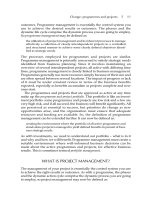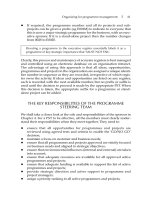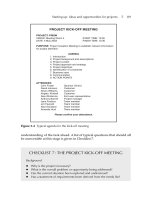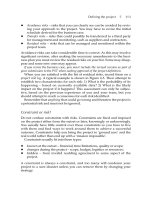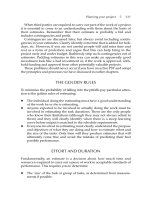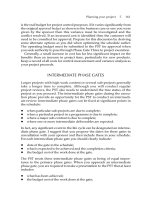oracle primavera p6 version 8 project and portfolio management a comprehensive guide to managing
Bạn đang xem bản rút gọn của tài liệu. Xem và tải ngay bản đầy đủ của tài liệu tại đây (8.31 MB, 348 trang )
Oracle Primavera P6
Version 8: Project and
Portfolio Management
A comprehensive guide to managing projects,
resources, and portfolios using Primavera P6,
through version 8.2.
Daniel L. Williams, PhD
Elaine Britt Krazer, PMP
professional expertise distilled
BIRMINGHAM - MUMBAI
Oracle Primavera P6 Version 8:
Project and Portfolio Management
Copyright © 2012 Packt Publishing
All rights reserved. No part of this book may be reproduced, stored in a retrieval
system, or transmitted in any form or by any means, without the prior written
permission of the publisher, except in the case of brief quotations embedded in
critical articles or reviews.
Every effort has been made in the preparation of this book to ensure the accuracy
of the information presented. However, the information contained in this book is
sold without warranty, either express or implied. Neither the author(s), nor Packt
Publishing, and its dealers and distributors will be held liable for any damages
caused or alleged to be caused directly or indirectly by this book.
Packt Publishing has endeavored to provide trademark information about all of the
companies and products mentioned in this book by the appropriate use of capitals.
However, Packt Publishing cannot guarantee the accuracy of this information.
First published: August 2012
Production Reference: 1140812
Published by Packt Publishing Ltd.
Livery Place
35 Livery Street
Birmingham B3 2PB, UK.
ISBN 978-1-84968-468-2
www.packtpub.com
Cover Image by David Gutierrez ()
Credits
Authors
Daniel L. Williams, PhD
Elaine Britt Krazer, PMP
Reviewers
Denitsa Banova
Robert W. Self, PMP
Deepak Vohra
Acquisition Editor
Rukshana Khambatta
Lead Technical Editors
Shreerang Deshpande
Sonali Tharwani
Technical Editors
Apoorva Bolar
Madhuri Das
Project Coordinator
Joel Goveya
Proofreader
Cecere Mario
Indexers
Hemangini Bairi
Tejal R. Soni
Graphics
Manu Joseph
Production Coordinator
Prachali Bhiwandkar
Cover Work
Prachali Bhiwandkar
About the Authors
Daniel L. Williams, PhD rst began working with Primavera in 2001 as part
of an integration project with JD Edwards World. Since then, he has helped clients
integrate Primavera with many other systems, such as PeopleSoft, Timberline, and
Oracle EBS. His work centers around helping people make best use of Primavera
and other software investments. Sometimes this involves heavy integration;
sometimes it involves customization and automation of business processes.
Sometimes it simply involves listening to people talk through their business goals
and helping them come up with workable solutions. Daniel's background includes
a Ph.D. in Physics from Caltech, many years of programming in C, C++, C#, and
Java, and for the past decade, leading numerous software development projects
oriented around Primavera
I would rst like to thank my wife Heather for being the cornerstone
of our family and allowing me to pursue a career I enjoy. I would
also like to thank Justin Cohen for his years as a friend and business
partner, and Patrick Martin for his long-term friendship, advice,
and support. This book would have not been possible without all
of the clients I have worked for over the years—Wendy Kaszycki,
David Myers, Sandy Kayser, Sally Rau, Beth Maclean, Cathy
Rosczewski, and many others. Their guidance is what drives me
to learn and improve every day, and their thanks is the greatest
reward for my labors.
Elaine Britt Krazer, PMP began working with Primavera products as a project
manager for a government contractor in a top secret environment in 2003. Having
managed projects since 1986, she embraces Primavera as her tool of choice. She
has written training materials and published materials that combine best practices
(as dened by the Project Management Institute® and from experience) and the
appropriate use of Primavera within client organizations. Her philosophy is that
understanding an organization's strategic goals for projects are the foundation
for project management excellence and Primavera is the tool of choice. She has
a master's certicate from George Washington University 2002, and Project
Management Professional (PMP®) and ITIL Foundations certications. She is an
Oracle Certied Primavera Implementation Specialist and is Primavera Training
Authorized. Elaine has worked in most major industries implementing Primavera.
Her past includes technical change management, business process redesign, data
center management, and PMO creation.
I would like to thank Daniel, the team at Packt Publishing, and my
family for their constant support during the writing of this book. I
am blessed.
About the Reviewers
Denitsa Banova works as a Primavera implementation consultant. She has
extensive experience in Portfolio/Program/Project Management gained in more
than ve years of work as a team leader, consultant, and trainer in Primavera
implementation projects in various IT companies, construction and manufacturing
sectors, and also as project manager in different software implementation projects.
Her specialties are Primavera P6 EPPM and Primavera P6 Professional.
I would like to thank Joel Goveya for being such a cooperative and
an understanding project coordinator.
Robert W. Self, PMP has over 20 years experience in training, implementation
and use of Primavera products with expertise in Primavera Project Manager (P6),
Contract Manager (Expedition), and Project Risk Manager (PertMaster).
He has written multiple training manuals to help students become power users of P3
and P6. These manuals range from basic concepts through advanced topics, such as
reporting, resource management, and use of Risk in P6.
Currently, Robert is a part of the project controls team at the DFW International
Airport, working directly with civil and facility project managers on a variety of
projects ($1M – $20M each project) throughout the entire project lifecycle. These
projects include basic renovation to Greeneld projects, even the occasional LEED
project. His daily duties include performing frontline evaluation of programmatic
(internal), as well as contractor schedules. In addition to his regular duties, he
provides mentoring to DFW colleges and contractors in terms of schedules and
project controls.
I would like to thank my wife, Sharon, for her patience and
understanding. She has been and remains my inspiration. She has
long suffered as a road warrior's wife.
I would also like to thank Mike Stone for giving me the opportunity
to get into the training and consulting business by working with the
Houston Primavera dealer. The variety of industries and clientele
proved an excellent crucible to focus my understanding and
appreciation of quality project management tools and techniques.
Deepak Vohra is a consultant and a principal member of the NuBean.com software
company. Deepak is a Sun certied Java programmer and web component developer,
and has worked in the elds of XML and Java programming and J2EE for over ve
years. Deepak is the co-author of the Apress book Pro XML Development with Java
Technology and was the technical reviewer for the O'Reilly book WebLogic: The
Denitive Guide. Deepak was also the technical reviewer for the Course Technology
PTR book Ruby Programming for the Absolute Beginner, and a technical editor for
the Manning Publications book Prototype and Scriptaculous in Action. Deepak is also
the author of the Packt Publishing books JDBC 4.0 and Oracle JDeveloper for J2EE
Development, Processing XML Documents with Oracle JDeveloper 11g, and EJB 3.0
Database Persistence with Oracle Fusion Middleware 11g.
www.PacktPub.com
Support les, eBooks, discount offers and more
You might want to visit www.PacktPub.com for support les and downloads related to
your book.
Did you know that Packt offers eBook versions of every book published, with PDF and ePub
les available? You can upgrade to the eBook version at www.PacktPub.com and as a print
book customer, you are entitled to a discount on the eBook copy. Get in touch with us at
for more details.
At www.PacktPub.com, you can also read a collection of free technical articles, sign up for a
range of free newsletters and receive exclusive discounts and offers on Packt books and eBooks.
Do you need instant solutions to your IT questions? PacktLib is Packt's online digital book
library. Here, you can access, read and search across Packt's entire library of books.
Why Subscribe?
• Fully searchable across every book published by Packt
• Copy and paste, print and bookmark content
• On demand and accessible via web browser
Free Access for Packt account holders
If you have an account with Packt at www.PacktPub.com, you can use this to access
PacktLib today and view nine entirely free books. Simply use your login credentials for
immediate access.
Instant Updates on New Packt Books
Get notied! Find out when new books are published by following @PacktEnterprise on
Twitter, or the Packt Enterprise Facebook page.
Table of Contents
Preface 1
Chapter 1: Getting Started with Oracle Primavera P6 7
Product history 7
Enter Oracle 8
P3 and SureTrak 9
What's in the name? 9
P6 core concepts 11
Project Management Life Cycle 11
Activities 12
Resources 13
What's new in P6 Release 8 14
New in Release 8.2 15
Summary 19
Chapter 2: Getting Around: Understanding
and Customizing the P6 Interface 21
EPPM Web Client overview 22
Application menus 23
Tabs 24
Modules 25
Main screen 25
Logging into the P6 Client 26
Screen overview 30
Main menus 33
File menu 34
Edit menu 37
View menu 48
Project menu 48
Enterprise 49
Table of Contents
[ ii ]
Tools 50
Admin 53
Help 55
Customizing screens and saving layouts 56
Summary 57
Chapter 3: Organizing your Projects with EPS, OBS, and WBS 59
Enterprise versus project data 59
Organizational Breakdown Structure (OBS) 60
Enterprise Project Structure (EPS) 63
Work Breakdown Structure (WBS) 68
A simple example 71
Summary 75
Chapter 4: Creating a New Project and Work Breakdown Structure 77
Creating a new project using the New Project Wizard 77
Setting project properties 81
General 81
Notebook 83
Budget Log 83
Spending Plan 84
Budget Summary 85
Dates 85
Funding 86
Codes (project level) 87
Defaults 89
Resources 89
Settings 90
Calculations 90
Structuring the WBS of the project 92
General 93
Notebook 93
WBS Milestones 93
WPs & Docs 94
Earned value 96
Importing projects in the web client 97
General 101
Activity 102
Resources 102
Notebooks 104
Custom Field Mapping 104
Importing in the Professional Client 105
Exporting projects 108
Summary 110
Table of Contents
[ iii ]
Chapter 5: Adding Activities and Relationships 111
Activities 112
Oracle Primavera P6 compared to other tools 112
Oracle Primavera and scheduling best practices 113
Activity details 114
General 114
Codes 117
Expenses 117
Assignments 118
Documents 118
Feedback 118
Issues 119
Notebooks 119
Predecessors/Successors 119
Trace Logic 120
Risks 120
Activity types 120
Start milestone 121
Finish milestone 121
Task dependent 122
Resource dependent 122
Level of Effort 123
WBS summary 124
Relationships 125
Finish to Start 126
Start to Start 126
Finish to Finish 126
Start to Finish 127
Lag and oat 127
Working with Activities 128
Gantt chart 128
Table 129
Activity network 129
Summary 130
Chapter 6: Resources 131
Resources 131
Resources: General 133
Resources: Codes 134
Resources: Details 135
Table of Contents
[ iv ]
Resources: Units and Prices 136
Resources: Roles 137
Roles 138
Roles: General 138
Roles: Resources 139
Roles: Prices 139
Roles: Limits 140
Teams 140
Resource assignments 142
Resource curves 145
Calendars 147
Modifying calendars 148
Calendar priority 150
Summary 152
Chapter 7: Scheduling and Constraints 153
Scheduling activities 153
Understanding scheduling algorithms 155
Scheduling using CPM and P6 155
The scheduling algorithm 156
The formula for start and nish 157
Settings at the user level 158
Settings at the project level 160
Calculations 160
Scheduling (F9) options 161
Settings at the global level 165
Settings at the activity level 166
Activity types 166
Summary 173
Chapter 8: Issues and Risks 175
Thresholds 176
Issues 178
Risks: P6 Professional 180
Risks: P6 Enterprise 183
Summary 185
Chapter 9: Baselines and Statusing 187
Maintaining baselines 187
Updating a baseline 190
Baseline assignment 193
Table of Contents
[ v ]
Updating project status 195
Auto compute actuals 196
Percent complete 197
Entering hours 198
Actual dates 199
Actual costs 200
Resources 201
Summary 201
Chapter 10: Project Templates 203
Creating a new project template 204
Creating a template from an existing project 206
Creating a new project from a template 207
Inserting a WBS into an existing project 208
Summary 210
Chapter 11: Portfolios 211
Managing portfolios 212
Creating a portfolio 213
Portfolio Views 214
Scenarios 218
User Dened Fields (UDFs) 219
Summary 222
Chapter 12: Portfolio Analysis 223
The Portfolio Analysis screen 224
Scorecards 226
Choosing data to display 227
Columns 227
Waterline 228
Graphical displays 229
Pie charts 229
Histograms 232
Side-by-side histogram 233
Stacked histogram 235
Bubble charts 236
Summary 238
Chapter 13: Measuring and Scoring Projects 239
Scoring projects 239
Creating and using scenarios 242
Waterline Analysis 244
Summary 246
Table of Contents
[ vi ]
Chapter 14: Capacity Planning and ROI 247
Capacity Planning 247
Frame A—scorecard 249
Frame B—Gantt chart 251
Frame C—resources and roles 252
Frame D—Resource and Role Usage 253
Putting it all together 256
Return on Investment (ROI) 256
Summary 259
Chapter 15: Dashboards 261
Dashboard examples: 262
Managing dashboards 264
Customizing a dashboard 267
Content tab 267
General 268
Portfolio Views 268
Project Performance 269
Resources 272
Personal Information 276
Custom Portlets 278
Dashboard Layout 279
Access 280
Summary 281
Chapter 16: Resource Management 283
Planning 283
Planning by project 285
Planning by resource 286
Splitting 287
Assignments 288
Resource analysis 290
Summary 292
Appendix A: Integrations 293
Integration overview 293
Integration benets 294
Enforcing best practices 295
Ensuring data integrity 295
Fewer people handling more projects 296
Integration pitfalls 296
Over-analysis 296
Imposing external culture 297
Underestimating technical skillset 298
Table of Contents
[ vii ]
Integration possibilities 298
Integration technology 298
JD Edwards 299
E-Business Suite 301
PeopleSoft 304
Summary 305
Appendix B: Reporting 307
Reporting from Professional 307
Screen printing 308
Reports 310
Editing reports 312
Reporting from the web client 313
Screen printing 314
BI Publisher 314
Summary 318
Index 319
Preface
Oracle Primavera P6 is the most sophisticated and widely-used project portfolio
management software in the world today. Some people think of P6 as simply a
tool for scheduling projects, such as Microsoft Project, but on steroids. But while
P6 can be used to plan a project a simple as writing one book, it can also be used
to plan and manage a multi-year, globally-distributed set of engineering projects
involving tens of thousands of workers, machines, and materials. When used to its
fullest, it can give an organization the ability to manage current projects, plan future
projects, and make key metrics to improve processes and ensure future success.
Primavera P6 is a vast product, with so many parts and features that it can seem
overwhelming to the new user. And there are many aspects to discuss under the
topic P6, such as the system architecture and database models, the various APIs
and how they work, and ne-tuning P6 for optimal performance under varying
conditions. There are also many books on project management and scheduling,
centered around the principles set forth in the Project Management Body of
Knowledge (PMBOK).
This book is designed to be a gentle introduction to P6, covering all of the main
aspects of the product from a user's point of view. Novices to P6 may read this
book from end to end, trying out the features and working through the examples
as they read along. For those who already know P6, or perhaps P3, OpenPlan, or
some similar product, this book serves as a refresher and shows the capabilities
of P6 in its current release, what features there are, what they are for, and how to
use them. Each chapter of this book covers one or more core features, and each of
these features can be explored at a much greater depth than can be contained in
these pages. It is the sincere hope of the authors that this book will serve your
needs as you and your team use Primavera P6 to manage your projects and to
continually improve your project management expertise.
Preface
[ 2 ]
What this book covers
Chapter 1, Getting Started with Oracle Primavera P6, reviews the history and core
concepts of P6 and introduces the new features in version 8.
Chapter 2, Getting Around: Understanding and Customizing the P6 Interface, walks you
through logging into P6 Professional and P6 web, and gives an overview of the key
menus and screens in both applications. Users will also be shown how to customize
the screens to best meet their needs.
Chapter 3, Organizing your Projects with EPS, OBS, and WBS, introduces the
organizational elements of P6. The Enterprise Project Structure (EPS) organizes
projects, and the Organizational Breakdown Structure (OBS) organizes people.
Traditionally, EPS matches internal divisions within a company, and OBS matches
the employee hierarchy. We also show how the WBS is used to organize work within
a project. This chapter also covers how OBS relates to project access and security.
Chapter 4, Creating a New Project and Work Breakdown Structure, takes readers through
setting up a new project, detailing all of the decision points including how to enter
WBS according to best practices. We also discuss creating project codes and show
how codes are used for other P6 entities as well. The chapter closes with a discussion
of importing projects into P6 from other sources.
Chapter 5, Adding Activities and Relationships, shows the many types of activities and
explains the relationships that can be created between them.
Chapter 6, Resources, discusses resources and roles, how they are created, organized,
and used globally and within projects. This chapter will also cover how costs are
associated with roles and resources.
Chapter 7, Scheduling and Constraints, zeros in on the heart of P6 scheduling. It will
discuss the algorithms used and how to run schedule calculations. It also explains
the many different settings in P6 that affect the scheduling algorithm.
Chapter 8, Issues and Risks, illustrates how to keep projects on track using issues and
risks. Readers will learn to create, manage, and report on issues. Readers will also
learn how to create project risks and how to track, manage, and report on risks.
Chapter 9, Baselines and Statusing, describes how to manage changes in a project
schedule using baselines. We also discuss updating project status and entering actuals.
Chapter 10, Project Templates, illustrates the concept of project templates, which can
be used to quickly generate new projects in a consistent manner.
Preface
[ 3 ]
Chapter 11, Portfolios, steps above the project level and discusses portfolios, how to
coherently manage and analyze sets of projects. In this chapter, we show how to
collect projects into static and dynamic portfolios. Readers will learn about key
built-in project-level elds and how to group data for Portfolio Analysis. We also
discuss user-dened elds (UDFs) and how to use these when creating portfolios.
Chapter 12, Portfolio Analysis, introduces the tools of portfolio analysis, such as
scorecards and graphs, and shows how to use these to compare portfolio data.
Chapter 13, Measuring and Scoring Projects, discusses creating portfolio scenarios,
scoring projects, and using waterline analysis.
Chapter 14, Capacity Planning and ROI, shows how to use P6 to plan out resource usage
across projects. We also discuss how P6 calculates Return on Investment (ROI).
Chapter 15, Dashboards, presents real-time reporting using dashboards. These
allow users to focus on the data they need the most. We show the wide variety of
dashboards available, and how to customize and make your own dashboards.
Chapter 16, Resource Management, discusses the features of P6 that allow you to
manage resources across the enterprise by analyzing resource requirements,
requesting resources for projects, and committing resources to projects.
Appendix A, Integrations, gives a high-level overview of the key integrations
provided by Oracle that tie data between P6 and each of Oracle's three key
ERP systems—E-Business Suite, PeopleSoft, and JD Edwards.
Appendix B, Reporting, discusses the many ways to obtain and view data from
P6, including screen printing and the built-in reporting engine in P6 Professional,
and using BI Publisher in P6 EPPM.
What you need for this book
In order to get the most out of this book it is helpful to have a copy of P6 at hand
so that you may try out the concepts for yourself. It is also very helpful to have
one or more actual projects to work with, so that you can apply what you learn
as you read along.
The easiest way to obtain P6 is to visit
edelivery.oracle.com. If you do not already
have an Oracle account, go ahead and make one, as it costs nothing and gives you
access to a wide variety of resources, such as forums.oracle.com and support.
oracle.com
, which contains a rich variety of knowledge articles and allows you to
communicate with other Primavera users and the Oracle support team.
Preface
[ 4 ]
Once you have logged-in and read and accepted the licensing terms and restrictions,
you may search for and download many Oracle products. Choose the Product Pack
called Primavera Applications and then choose the proper platform that you need.
Note that the screen will show many Primavera products besides P6, and will
show many versions of P6 as well. By default, the products are arranged by release
number. It is helpful to click on the Updated column twice so that the products
are sorted by the one most recently updated. In the following screenshot we have
highlighted P6 Enterprise version 8.2:
P6 Professional is in general much easier to install on your own system. P6
Enterprise (the web version) will require a greater deal of technical know-how,
as you will be installing WebLogic and BI Publisher as well as P6.
Preface
[ 5 ]
If your company already has an installation of P6, then see if you can have someone
create a database instance just for you to work with as you go through the book. This
will allow you to try out all of the functionality of P6 without the risk of altering the
production-level system.
Who this book is for
This book is for people who are new to P6 and who want an overview of the
full product, and for people who are familiar with P6 or similar products, who
want to understand the features available in version 8. It is a broad outline of P6,
covering all of the aspects of the product. The reader is expected to have some basic
understanding of scheduling concepts, as this book is by no means a stand-alone
introduction to that vast topic!
While reading this book, the reader is encouraged to follow along and try out the
ideas presented in each chapter. Hands-on experience, using real-world projects,
is the best way to master P6.
Conventions
In this book, you will nd a number of styles of text that distinguish between
different kinds of information. Here are some examples of these styles, and an
explanation of their meaning.
New terms and important words are shown in bold. Words that you see on the
screen, in menus or dialog boxes for example, appear in the text like this: The Role
Limit may be selected from either the resource limit of the Primary Resource or the
custom limit assigned to the Role.
Warnings or important notes appear in a box like this.
Tips and tricks appear like this.
Reader feedback
Feedback from our readers is always welcome. Let us know what you think about
this book—what you liked or may have disliked. Reader feedback is important for
us to develop titles that you really get the most out of.
Preface
[ 6 ]
To send us general feedback, simply send an e-mail to ,
and mention the book title through the subject of your message.
If there is a topic that you have expertise in and you are interested in either writing
or contributing to a book, see our author guide on
www.packtpub.com/authors.
Customer support
Now that you are the proud owner of a Packt book, we have a number of things to
help you to get the most from your purchase.
Errata
Although we have taken every care to ensure the accuracy of our content, mistakes
do happen. If you nd a mistake in one of our books—maybe a mistake in the text or
the code—we would be grateful if you would report this to us. By doing so, you can
save other readers from frustration and help us improve subsequent versions of this
book. If you nd any errata, please report them by visiting ktpub.
com/support
, selecting your book, clicking on the errata submission form link, and
entering the details of your errata. Once your errata are veried, your submission
will be accepted and the errata will be uploaded to our website, or added to any list
of existing errata, under the Errata section of that title.
Piracy
Piracy of copyright material on the Internet is an ongoing problem across all media.
At Packt, we take the protection of our copyright and licenses very seriously. If you
come across any illegal copies of our works, in any form, on the Internet, please
provide us with the location address or website name immediately so that we can
pursue a remedy.
Please contact us at
with a link to the suspected
pirated material.
We appreciate your help in protecting our authors, and our ability to bring you
valuable content.
Questions
You can contact us at if you are having a problem with
any aspect of the book, and we will do our best to address it.
Getting Started with
Oracle Primavera P6
In this chapter, we introduce Oracle Primavera P6 Enterprise Project Portfolio
Management or P6 for short. P6 is used worldwide to schedule projects in a range
of industries, including construction, energy, aerospace, pharmaceuticals, IT, and
nance, to name a few. At rst glance, the program may appear daunting in the
scope of its capabilities. It is the hope of the authors that this book will establish
for our readers a strong foundation in P6 that will allow them to use P6 with
condence on a daily basis.
In this chapter we will cover:
• Product history
• What's in the Name?
• P6 Core Concepts
• What's New in P6 Release 8
Product history
The core concepts of project scheduling were laid down in the years following World
War II, as construction projects in the United States became larger and more complex.
By the 1960s, these concepts were being implemented in mainframe computers by such
entities as DuPont, IBM, and the U.S. military.
Getting Started with Oracle Primavera P6
[ 8 ]
In 1983, Joel Koppelman and Dick Faris founded Primavera Systems in Philadelphia.
Their vision was that these same principles of project management could be
implemented on desktop PCs, which were then just making their way into common
use. The rst product went on sale in 1983, available on a set of 5¼-inch oppy disks
that held a whopping 360 KB of data each. The application required 256 KB of RAM
to run, which was quite a lot at the time.
And so Primavera Project Planner (P3) was born. The company was quite successful
and eventually P3 became the leading scheduling product in the engineering and
construction industries. In fact, it soon became a requirement for certain government
contracts that schedules could only be delivered in a P3-compatible format.
In the late 1990s, with the rise of networks and the Internet, it became clear that the
future of project scheduling software lay beyond a single product installed on one
person's desktop. Instead, project scheduling was moving towards systems that
could be accessed simultaneously by multiple people in different locations.
In 1999, Primavera acquired Eagle Ray Software. This company had created a
product in 1998 called Eagle Ray 1000 Project Management Suite. Primavera took
ER1000 and released it as two products in 1999: P3 e/c, which was marketed for
Engineering and Construction, and TeamPlay for IT and Financial services. Over
the years, the products have appeared to merge and diverge, adding capabilities
such as timesheet entry, integration, and portfolio analysis, eventually evolving
into what is now called P6. In 2004, Primavera 5.0 was released, and in 2007, P6.0
was released, followed by P6.2 in 2008.
In 2008, another major change occurred. Primavera, a privately held company,
was bought by Oracle, a publicly held corporation.
Enter Oracle
In 2008, soon after P6.2 came out, it was announced that Oracle Corporation was
buying Primavera. Starting as a database provider in 1979, Oracle had grown over
the years into a large and inuential company, focused not only on databases, but
on providing an array of software products that are fundamental to managing
modern businesses. This array included enterprise resource planning (ERP)
systems, content management systems, analytical and reporting systems, and
application servers and technology, to describe just a few. In order to ensure that
they also owned the best-of-breed in project scheduling software, Oracle acquired
Primavera Systems in 2008.

![wiley finance, investment manager analysis - a comprehensive guide to portfolio selection, monitoring and optimization [2004 isbn0471478865]](https://media.store123doc.com/images/document/14/y/xf/medium_QyYI7IBVAK.jpg)


